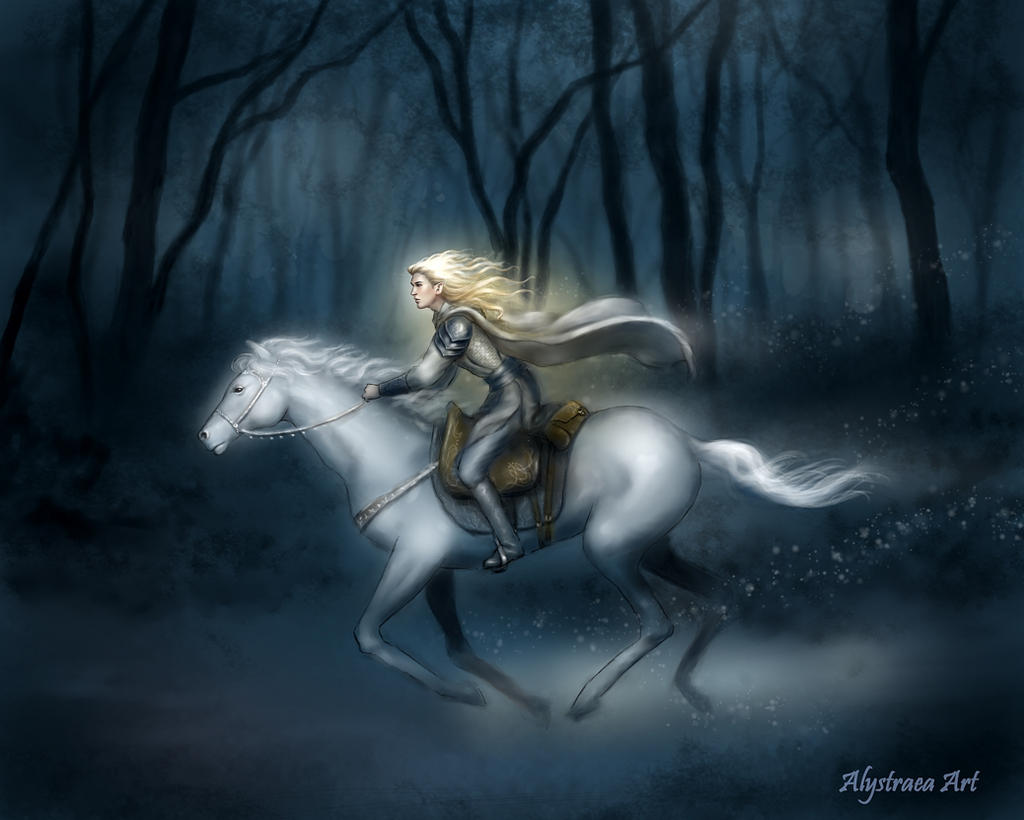Sindarin is the language Elves would use for everyday purposes and
conversation. Also called "the grey-elven speech," Sindarin is inspired by
Welsh, and is found throughout The Lord of the Rings, where it is used not only by Elves but also by the Dunedain
(such as Aragorn), Gandalf, and a few of the hobbits. Here is an
example (The Fellowship of the Ring, Many Meetings):
| A Elbereth Gilthoniel |
| silivren penna míriel |
| o menel aglar elenath! |
| Na-chaered palan-díriel |
| o galadhremmin ennorath, |
| Fanuilos le linnathon |
| nef aear, sí nef aearon! |

|
|
Glorfindel's greeting to Aragorn:
Ai na vedui, Dúnadan! Mae govannen!
|
Quenya is the language that Tolkien described as "Elvish Latin," and in
The Lord of the Rings it is sometimes called "the high-elven speech"
or "the Ancient Tongue." It would be used by the Elves for ceremonial
occasions and "high matters of lore and song" rather than for everyday
speech, and had a more ancient history than Sindarin. Quenya is inspired by
Finnish, as well as Latin and Greek, with a heavily inflected grammar
structure and vowel-heavy vocabulary. The longest example of Quenya
written by Tolkien is the farewell song that Galadriel sings to the
Fellowship, a lament called Namárië (The Fellowship of the Ring, Farewell to Lorien). Here is the first
stanza:
| Ai! laurië lantar lassi súrinen, |
| yéni únótimë ve rámar aldaron! |
| Yéni ve lintë yuldar avánier |
| mi oromardi lissë-miruvóreva |
| Andúnë pella, Vardo tellumar |
| nu luini yassen tintilar i eleni |
|
ómaryo airetári-lírinen. |

|
|
"Now she sang in the ancient tongue of the Elves beyond the Sea...fair was the song, but it did not comfort him." |
If you compare the two texts, you can see that Sindarin words tend to end
with consonants and contain very few diacritical marks, while Quenya words tend
to end with vowels and contain more vowels in general. In this text
sample, Sindarin contains many more consonant pairs like th, gl,
lb, dhr, and ch, while Quenya rarely has two successive consonants and uses the letter y much more often; the difference in letter frequency
and combinations helps the two languages look distinct from each other. To
me, Sindarin looks more familiar, like a language you could pronounce even
if you can't understand the words, while Quenya seems more alien, with more unusual phonetic combinations.
Are you inspired to reread The Lord of the Rings with an eye to those
odd bits of other languages Tolkien scatters so liberally? If you begin to
get a feel for the sound and look of Sindarin as opposed to Quenya, you will
not only be able to tell them apart yourself and impress your friends, but
(I hope) will join me in raising one eyebrow at those less well informed
writers who go around announcing Tolkien's invention of that non-existent
language "Elvish."
Yours etc.
Liv Quicksilver




No comments:
Post a Comment
Please leave your thoughts! - L.Q.